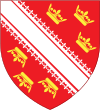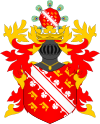| This article includes a list of references, related reading, or external links, but its sources remain unclear because it lacks inline citations. Please help improve this article by introducing more precise citations. (July 2013) (Learn how and when to remove this message) |
| Prince-Bishopric of StrasbourgFìrschtbischofsìtz Strossburi(g) (Alsatian) Fürstbistum Straßburg (German) | |||||||||||
|---|---|---|---|---|---|---|---|---|---|---|---|
| 982–1803 | |||||||||||
 Flag
Flag
 Coat of arms
Coat of arms
| |||||||||||
 The Prince-Bishopric of Strasbourg, circa 1547 The Prince-Bishopric of Strasbourg, circa 1547 | |||||||||||
| Status | Prince-Bishopric | ||||||||||
| Capital | Straßburg | ||||||||||
| Common languages | Alsatian | ||||||||||
| Historical era | Middle Ages | ||||||||||
| • Prince-Bishopric founded | before 343 | ||||||||||
| • Gained autonomy | 775 982 | ||||||||||
| • Imperial immediacy | 982 | ||||||||||
| • Left-bank territories annexed by France | 1681 | ||||||||||
| • Annexation recognised by the Holy Roman Empire | 1697 | ||||||||||
| • Right-bank territories mediatised to Baden | 1803 | ||||||||||
| |||||||||||
| Today part of | |||||||||||
The Prince-Bishopric of Strasburg (German: Fürstbistum Straßburg; Alsatian: Fìrschtbischofsìtz Strossburi(g)) was an ecclesiastical principality of the Holy Roman Empire from the 13th century until 1803. During the late 17th century, most of its territory was annexed by France; this consisted of the areas on the left bank of the Rhine, around the towns of Saverne, Molsheim, Benfeld, Dachstein, Dambach, Dossenheim-Kochersberg, Erstein, Kästenbolz, Rhinau, and the Mundat (consisting of Rouffach, Soultz, and Eguisheim). The annexations were recognized by the Holy Roman Empire in the Treaty of Ryswick of 1697. Only the part of the state that was to the east of the Rhine remained; it consisted of areas around the towns of Oberkirch, Ettenheim, and Oppenau. This territory was secularized to Baden in 1803.
See also
References
- Herbermann, Charles, ed. (1913). "Strasburg" . Catholic Encyclopedia. New York: Robert Appleton Company.
| Ecclesiastical |  | ||||
|---|---|---|---|---|---|
| Secular | |||||
| Counts / Lords |
| ||||
| Cities |
| ||||
| Part of the Three Bishoprics. Nomeny after 1737. without Reichstag seat. until 1736. Joined Swiss Confederacy in 1515. Circles est. 1500: Bavarian, Swabian, Upper Rhenish, Lower Rhenish–Westphalian, Franconian, (Lower) Saxon Circles est. 1512: Austrian, Burgundian, Upper Saxon, Electoral Rhenish · Unencircled territories | |||||
| Catholic League (1609–1635) within the | ||
|---|---|---|
| Abbacies |  | |
| Bishoprics | ||
| Archbishoprics | ||
| Duchies | ||
48°35′4″N 7°44′55″E / 48.58444°N 7.74861°E / 48.58444; 7.74861
Categories:
